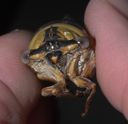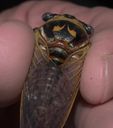Walker's Cicada
Megatibicen pronotalis
Classification
- Phylum: Arthropoda
- Subphylum: Hexapoda
- Class: Insecta
- Order: Hemiptera
- Suborder: Auchenorrhyncha
- Infraorder: Cicadomorpha
- Superfamily: Cicadoidea
- Family: Cicadidae
- Subfamily: Cicadinae
- Tribe: Tacuini
- Genus: Megatibicen
- Species: pronotalis
Pronunciation
How to pronounce Megatibicen pronotalis: //mɛɡəˈtɪbɪˌsɛn prəˈnoʊtəlɪs//
These audio files are automatically generated. While they are not always 100% accurate, they are a good starting point.
Images




Summary
Megatibicen pronotalis, known as Walker's cicada, is one of the largest cicadas in the eastern USA, notable for its loud alarm calls and varied coloration. Found primarily in riparian habitats, this species has poorly defined subspecies based on geographic distribution and coloration.
Physical Characteristics
Megatibicen pronotalis has a robust body with a relatively narrow head compared to the thorax. Body coloration varies and includes forms such as 'Lime-Green', 'Light Olive/Taupe', 'Greenish Ochreous-Tan', and 'Ochreous' or 'Yellow-Orange'. Average body length ranges from 3 to 4 cm, forewing length is approximately 5 cm, and wingspan is 10-13 cm. Males have oblique/rounded opercula that are ochreous to olive-yellow colored.
Identification Tips
Distinguish from Tibicen dealbatus by the greater pruinosity on the thorax and abdomen seen in dealbatus. T. pronotalis typically has less pronounced 'Z' infuscation towards the ends of the forewings. Males call with a deep rhythmic 'Yeee-Yeee-Yeee...' which can help identify them.
Habitat
Riparian ecosystems with large quantities of Populus (Cottonwood) and Salix (Willow), often in association with sycamores and various hardwood forests.
Distribution
Northern Great Plains of the USA, including eastern Texas, eastern Oklahoma, Louisiana, Arkansas, Missouri, eastern Kansas, eastern Nebraska, South Dakota, North Dakota, Illinois, Indiana, Ohio, western Kentucky, western Tennessee, Mississippi, Alabama, southwestern Georgia, and northern Florida.
Diet
Nymphs feed on sap from roots of host plants, preferring Pines; adults are likely sap feeders as well.
Life Cycle
Eggs are typically laid in dead twigs, wood, or bark and may hatch after a few weeks. Nymphs burrow into the soil where they feed for several years before emerging as adults, usually at night.
Reproduction
Females lay eggs in dead or living twigs. Nymphs develop underground for several years before emerging as adults.
Predators
Not specified.
Conservation Status
Not specified.
Ecosystem Role
As both nymphs and adults, they play a role in nutrient cycling and serve as prey for various birds and other predators.
Economic Impact
Reported among the loudest insects, which may disturb human activity but otherwise not significantly cited for economic impact.
Cultural Significance
Not specified, but noted for loud calls contributing to the soundscape of summer.
Health Concerns
Not specified.
Evolution
Megatibicen pronotalis is closely related to Tibicen dealbatus, potentially forming a cline with genetic exchange, though they are recognized as distinct species.
Similar Taxa
Misconceptions
Often confused with closely related species such as Tibicen dealbatus due to similar calls and overlapping habitat and morphology.
Tags
- Cicada
- Megatibicen pronotalis
- Walker’s cicada
- Entomology
- Insect
- Hemiptera